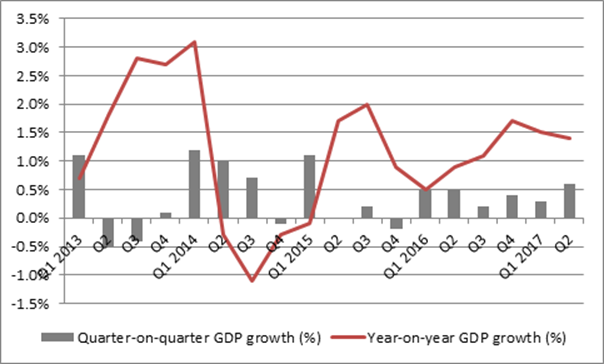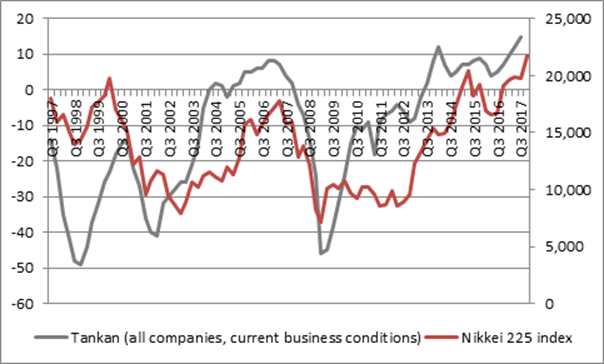Russ Mould, investment director at AJ Bell, comments:
“Sagging approval ratings for the administration suggest that the Japanese electorate is still far from convinced by the Prime Minister’s ‘Three Arrows’ programme, dubbed ‘Abenomics,’ and Abe’s third straight election win owed as much to the feeble opposition as it did his own strength.
“Yet financial markets remain in thrall to the three-point programme laid out when he first took power in December 2012, as the Nikkei 225 index now trades at a two-decade high and it is easy to see why.
“In the second quarter of 2017, Japan racked up its sixth straight period of growth, its longest run for a decade, and its best sequential rate of improvement for over two years.

Source: Thomson Reuters Datastream
“In addition, the Tankan, the major quarterly corporate sentiment survey, offered a 10-year high reading in early October for both large and smaller manufacturers, while the number of firms citing labour shortages reached levels seen since 1992.
“The Nikkei seems to track the Tankan (or vice-versa) pretty slavishly so this should be a good sign.

Source: Thomson Reuters Datastream, Bank of Japan
“Yet improved GDP and tighter labour markets have yet to translate into the wage (or wider) general inflation which the Bank of Japan and Abe want to see, not least as that would help to inflate away Japan’s monstrous government debts, which come to around 240% of GDP. That is the highest such figure in the world and it leaves Japan in the less-than-exalted company of such economic problem children as Greece, Jamaica, the Lebanon and Italy.
“Inflation has stubbornly refused to consistently advance toward the BoJ’s 2% inflation target and as Japan approaches the 29th anniversary of the peak of its debt-fuelled property and stock market bubble this is why Japan remains a test case for the Quantitative Easing and negative or zero-interest rate policies now also being employed in the West.
“Japan has tried at least a dozen rounds of QE, held interest rates below 1.00% since 1996 and multiple rounds of fiscal stimulus – but to no great lasting effect.
“The Bank of Japan still seems to be firmly committed to its ¥80 trillion a year QE scheme and headline interest rate of -0.1%, even as the US Federal Reserve raises interest rates, the Bank of England ponders a tightening of policy and the European Central Bank edges toward tapering the amount of monetary stimulus it is pumping into the system.
“It will therefore be fascinating to see which approach works out best. Japan is working on the principle that ultra-loose policy only failed because it was not loose enough. The Fed now seems to be coming to the point of view that QE and low rates can have unintended consequences (such as bubbly asset markets and soaring corporate pension deficits), issues with which the Bank of England is also wrestling.”
Shinzō Abe: set to become Japan’s longest-serving PM?
Victory in October’s carefully-planned snap general election means Prime Minister Shinzō Abe is within touching distance of realising his goal of still being in power on 24 July 2020, when the opening ceremony for the Summer Olympics takes place in Tokyo.
Assuming he steers clear of any scandals, staying on for that long would also cement his legacy in another way.
Abe’s first term of office in 2006-07 lasted precisely 365 days. Add that to the stint that began in December 2012 and if Abe gets to 2020 he will overtake Eisaku Satō as the longest-serving modern-day Japanese leader (and for good measure even the all-time leader Tarō Katsura, who served three separate terms between 1901 and 1913).
Prime Minister | Party | Span of office * | Total days in office |
Tarō Katsura | Dōshikei | 1901-1913 | 2,883 |
Eisaku Satō | Liberal Democratic Party | 1964-1972 | 2,797 |
Hirobumi Itō | Seiyūkai | 1885-1901 | 2,716 |
Shigeru Yoshida | Liberal Democratic Party | 1946-1954 | 2,614 |
Shinzō Abe | Liberal Democratic Party | 2006-current ** | 2,126 ** |
Junichiro Koizumi | Liberal Democratic Party | 2001-2006 | 1,979 |
Yasuhiro Nakasone | Liberal Democratic Party | 1982-1987 | 1,805 |
Hayato Ikeda | Liberal Democratic Party | 1960-1964 | 1,574 |
Kinmochi Saionji | Seiyūkai | 1901-1912 | 1,421 |
Nobusuke Kishi | Democratic Party | 1957-1960 | 1,265 |
Source: Asahi Shimbun, Nikkei Newspaper. * Dates span all periods in office which may not have been consecutive. ** As of General Election victory on 22 October 2017